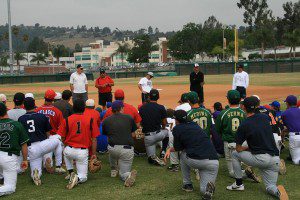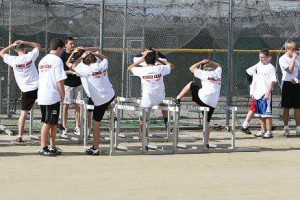Eat to Win: Nutrition for the Student Athletes Part III
Posted by Evelyn Hallford in Nutrition, Training, tags: Nutrition, TrainingLet’s get your game on! How you fuel and train your body should depend on your game, what you play and how you want to play it. In my last article we talked about the three different energy systems used in athletic performance: the phosphagen system, the anaerobic system, and the aerobic system. Today, we’ll talk about the energy systems used for short term energy use and how to optimize your fuel consumption for your energy needs.
A swimmer dives off the starting block; a batter hits the ball; a tennis player serves up the ace. These are all examples of energy expenditures in the phosphagen and anaerobic systems. An athlete’s body can access either of these systems for quick burst, intense activities.
The body uses the phosphagen system when you need quick power. Think explosive when you think of the fuel stored in our muscles called creatine phosphate. CP helps to create ATP very rapidly and thus burns it very rapidly as well. Foods that contain creatine include meats, poultry, and fish. The occasional protein bar or creatine shake won’t hurt you, but these simply can’t provide the nutritional support, the big bang, that a slab of real grilled salmon provides. When this energy becomes exhausted the anaerobic system then becomes active to provide support for more high intensity, short burst activities.
The term anaerobic refers to processes that do not require oxygen. The anaerobic energy system relies on glucose as it’s major source of ATP. Glucose is simply a form of sugar easily used by the body. Carbohydrates are the major source of glucose and are stored in the form of glycogen within our muscles and liver. This system is called into action when an athlete first begins activity and will continue to provide energy until oxygen is available to help meet the body’s demands for activity over three minutes in duration. When a football player catches the ball in the end zone and runs at lightning speed for the return, the athlete is using up glucose. High quality carbohydrates are crucial for an athlete, male or female of any age or weight. You can’t simply power down a powdered sugar donut for this fuel – the donut is burned up or turned to fat entirely too soon to improve performance. Instead, eat smaller portions of quality carbs more often, like whole grain pasta, brown rice, or whole wheat bread. If an athlete chooses the powdered sugar donut as their fuel of choice, glycogen stores will be low resulting in low production of ATP and lower energy levels which have a negative impact on athletic performance. During elevated levels of activity, the body will start to accumulate lactic acid at a rate that exceeds the liver’s ability to eliminate it if the athlete cuts the carbs too far back. So, if you get an intense side ache during practice, it is a reminder that powdered sugar donuts are poor fuel for the anaerobic system.
So, what’s your game? Do you need power? Do you need quick, short bursts of intense speed? Do you need to keep going and going and going? Can anybody play? Probably. But, if you want to play better, perform better, then think of food as fuel for your amazing energy systems. In part 4 of Eating to Win, we’ll talk about the role of our aerobic energy system!






